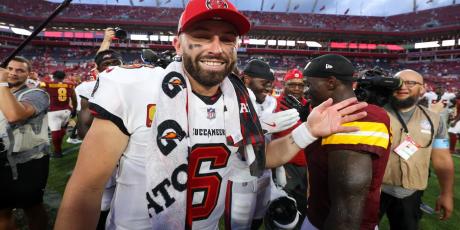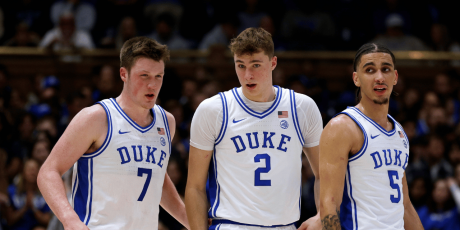Jared Cook: Is the Grass Greener in Oakland?

On Thursday afternoon, the Raiders announced the signing of TE Jared Cook, a move that certainly bolsters the Oakland offense overall, but doesn’t clear up much in terms of Cook’s fantasy value.
Last season, Cook ended on a bit of a tear, averaging a 5.2/68/0.3 line, or 14 PPR FP/G, on 8.8 targets from Week 15 on (including the playoffs) -- albeit with a depleted Packers receiving corps. But does that six-game sample tell the entire story?
A 2016 Overview
While Cook has been fantasy fool’s gold for most of his career, he got a bit of a pass from fantasy owners while stuck on the futile Jeff Fisher-led Rams offenses from 2013-2015. In 2016, Cook was blessed with arguably the best quarterback in the league. With that came hopes of a TE1 season.
While Green Bay’s passing game flourished last year, Cook remained mired in mediocrity. Even if we include his huge playoff run, Cook scored just 1.53 PPR FP/target, a number that ranked fourth out of five Packers that had at least 50 targets, as well as 24th out of 31 qualifying TEs.
A metric like FP/target is heavily weighted towards scoring touchdowns, but opportunities were presented to Cook near the goal line -- he was one of 47 players across all positions to see at least 15 red zone targets in 2016. Cook converted just 20% of those looks into scores, however, placing him in the bottom half of the league in red zone touchdown rate among qualifying players, as well as 10th among 14 qualifying TEs.
Cook's teammates Davante Adams and Jordy Nelson converted 40.7% and 35.3% of their red zone looks, respectively, last season. Cook squandered a golden (and green) opportunity.
Is the Grass Greener in Oakland?
When a pass catcher moves to a new team, we want him to see an increase in either role or volume; ideally both. For Cook, that promotion is unlikely.
Oakland will return their top four receivers from last season in terms of target market share. Even if Cook absorbed every TE target, he’d still only stand to see about 14% market share based on 2016 numbers. Barring injury, Michael Crabtree and Amari Cooper should have a relatively firm grasp on their 22%+ market shares. Meanwhile, Seth Roberts saw his targets increase from 55 in 2015 to 77 in 2016. He has seemingly carved out his niche as a steady WR3 for Derek Carr, who he came into the league with.
In terms of the overall pie, it appears that Oakland's team passing volume doesn’t have much room for growth. Oakland threw on 58% of plays in 2016, which was right at the league average, but the Raiders already ranked in the top 10 in the league in pass attempts. They are expected to be one of the favorites in the AFC in 2017, meaning that game flow is unlikely to dictate a huge uptick in passing volume. Additionally, Oakland boasts one of the top offensive lines in the league, which they will surely use to maximize their return on the signing of Marshawn Lynch.
The one glimmer of hope for Cook could be new offensive coordinator, Todd Downing. For the last two seasons, Oakland’s offense was led by Bill Musgrave, who in eight seasons as a play caller has only had one TE ever finish a season with over 50 catches. In Downing’s two previous stints as an NFL coach, he was on staffs that gave Scott Chandler 71 targets in Buffalo and offered Brandon Pettigrew 100+ targets three times in Detroit. Which TE philosophy Downing implements is still to be determined, as he has never called plays at the NFL level.
Can Cook Offer a Return on Your (Small) Investment?
In fantasy drafts, almost any player is a value at some point. In best ball leagues, this is especially true since we get to cherry pick the best weeks and even more so for TEs, where week-to-week scoring is extremely volatile. Because of that volatility, I want at least two TEs that can offer relatively consistent production with a decent ceiling, since all but the very top players at the position will serve up starter points on a week-to-week basis.
Here’s a look at the players going in the TE2 range with my thoughts on a few them:
| NAME | POS | POS.ADP | ADP |
|---|---|---|---|
| Martellus Bennett | TE | 13 | 119.24 |
| Austin Hooper | TE | 14 | 143.43 |
| O.J. Howard | TE | 15 | 145.68 |
| Jack Doyle | TE | 16 | 150.96 |
| C.J. Fiedorowicz | TE | 17 | 153.86 |
| Coby Fleener | TE | 18 | 156.26 |
| Jared Cook | TE | 19 | 162.18 |
| Julius Thomas | TE | 20 | 163.72 |
| Jason Witten | TE | 21 | 165.54 |
| Ladarius Green | TE | 22 | 166.99 |
| Dwayne Allen | TE | 23 | 179.18 |
- Martellus Bennett has shown that he has TE1 upside and should take advantage of having Aaron Rodgers throwing him the ball much better than Cook did.
- Jack Doyle looks like the clear TE1 on an offense that loves to target the position and should be among the highest scoring teams in the league.
- As long as Bill O’Brien is in Houston, they will utilize the TE and last year BOB made it clear that Fiedorowicz is his guy.
- Say what you will about Coby Fleener’s talent, but the Saints will score through the air and Drew Brees is always going to spread it around.
- A TE1 finish is well within the range of outcomes for Julius Thomas.
- Jason Witten is almost a lock to see a near 20% target share.
- When healthy, the Steelers targeted Ladarius Green almost as often as any player in the league.
- Since being drafted, Dwayne Allen has the third-highest red zone touchdown rate among TEs, while Gronk has missed 24 games over the last five seasons.
The Bottom Line
When drafting the TE position in MFL10s, I want players with TE1 upside on a weekly basis. Even with a top-tier TE on my roster, settling for a middling TE2 can be leaving points on the table -- the best-ball format will reward two high-scoring TEs by rostering one in the flex and hitting the jackpot in the double-digit rounds often determines who wins the league. Remember, in MFL10s only first place gets paid, so draft strategy should often favor upside over consistency.
Given the other TEs being drafted around Jared Cook and his capped ceiling in Oakland, the new Raiders TE doesn’t have the upside that I want in a league where only the top dog eats. At least for early-season MFL10s, my exposure to Cook will be limited to teams where I find myself needing a TE3.
Editor's Note: 4for4's popular DFS Subscription will be making major upgrades for 2017! Subscribe now and get an an early-bird discount!






















